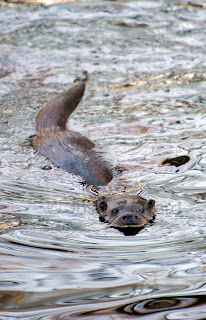Facebook: https://www.facebook.com/JoshJaggardPhotography
In the past few months I have herd a few rumours about an otter on a local river, where I photograph regularly. After speaking to around 15 different people and visiting the site a number of times, I narrowed down the most likely area I would see it. But after reports that an otter had been killed on the road last week, my hopes weren't to high.
Two days ago I was luckily enough to see 2 otters briefly swimming down the river before disappearing, which was great news. This meant that there must be a family or a good number of otters in the area considering one was killed the other day and I had still seen 2.
This morning I got up in the frost and went in search once again. After about an hour of nothing but dog walkers, I decided to move to a different part of the river. This was a hard choice as the lighting in the other part of the river was extremely bad. None the less I decided to try.
Straight away I saw some bubbles moving around on the water surface. This is a key sign of an otter swimming under the surface. I followed it and moments later an otter popped its head up. I decided to watch it for 5 minutes and see where it was likely to go and its current behaviour. I found that it was hunting in a specific spot. So when it went underwater again I quickly ran to the waters edge and got as low as possible, to prevent being spotted and getting a low photography angle.
For the next 15 minutes it stayed in the area and I got the following shots.
 | |
| Floating Otter |
 |
| Intrigued Otter |
 |
| Otter playing with some weed |
 |
| Otter swimming towards me |
 |
| Otter chewing on a small fish |
 |
| Head shot of the Otter |
 |
| Otter chewing some weeds |
 |
| Curious Otter |
This was a great experience and only my third ever encounter with an Otter. I am hoping to photograph them more in the coming weeks. The shot below was taken only half a meter away from me, Amazing experience.
 |
| Otter in hands reach |
Tips:
- Speak to as many locals as possible. They know more then anyone, especially dog walkers!
- Take a flask of tea, to keep warm on these cold morning. You will last longer in the field.
- Good field-craft = Better shots and closer encounters. Study the behaviour.
- Patience and perseverance.
- With otters, look for signs of otter spraint (excrement) and also look for bubbles on the surface.
https://www.facebook.com/JoshJaggardPhotography













































